Our first pilot customer started using iCombine this week. The launch went well, and now we are setting up individual accounts of our software for our next customers. In this post, we want to share our development story, give insights about the project planning challenges modern organizations are facing right now and how we are providing a solution with our software.
Lean back, enjoy the ride and if you find yourself agreeing to the challenges we lay out, do not hesitate to share your story with us!
Step by Step to the First Release
As a market oriented startup, we strive for rapid improvements of our underlying ideas. This is why we verify our assumptions and draw conclusions about our product development. A lot of communication and constant learning is key to all of this. Since we founded iCombine in 2016, we have aimed at creating software that enables its users to organize their work in the most transparent, collaborative and fulfilling way.
For the last five months, we have been working on realizing this goal. We analyzed current problems in project oriented companies by conducting more than 100 interviews. By demoing a clickable prototype, we were finally able to validate our approach for skill based project planning. Moreover, we started observing trends that were connected to the future of work. Self-organization, agile methodologies and flat hierarchies are only some topics to mention here. Based on all new findings and the valuable feedback from our interviews and demos, we are now presenting the first release, version 0.1.0, of iCombine. In this stage, customers can test the product and recognize the value of our solution in relation to the challenges they currently have.
Planning Challenges of Project Oriented Companies
In project oriented companies there is a constant need to assemble qualified teams for upcoming projects. That means, internal employees need to be staffed to upcoming projects and project roles appropriately. During our interviews and demos we realized that classical resource management is not applicable to a lot of modern work environments, especially when these “resources” are highly skilled and specialized employees.
Ideally, the requirements of a specific project role match the capabilities, interest, potentials and availability of an employee. Team members should complement each other respective to competency and personality. In a broader sense and to the organization’s benefit, competencies should be applied where they are needed.
Usually, a project manager is in charge of putting together a team during the initial stages of the project. This process does not only require knowledge about the project requirements, but also a knowledge about employees. We identified that in companies with more than 50 employees, a project manager can simply not know every combination of capabilities, interests and potential of each colleague. Unfortunately, this knowledge is scattered or implicit.
Let’s look more closely at availabilities and skills of employees. Companies we interviewed usually capture this data in excel sheets, ERP systems or calendars. But these tools do not help a manager when it comes to identifying employees that match the skill requirements of a upcoming project role. Some companies have resumé databases, but these often contain outdated information as they are not kept in sync with the ongoing work. Moreover, planners can not easily search these databases unless they use the exact same buzzword that was used by the creator of the resumé. Imagine searching for employees who have sales skills, but their resumé only lists key account management. You will not find these employees.
Due to this missing transparency and non-existent competency structures to guide the search process, project team staffing often becomes arbitrary and incomprehensible. That directly leads to frustration among employees: they feel displaced and excluded from staffing decisions, annoyed by bad project execution, unbalanced utilization and overtime work because of readjustments in the plan.
A Solution to Project Planning Challenges
We introduce the iCombine Software-as-a-Service, to address the project planning challenges of organizations that establish modern working environments. This includes concepts and methodologies like agile project/product management, self-organization, transparency, flat hierarchies and network organizations.
First Steps with iCombine
After a company decides to improve its planning process with our software, we set up their iCombine account. This account has a customized skill and competency structure that is based on the planning needs of the company. This is why iCombine is not limited to a specific sector: we can improve planning processes for marketing, engineering and consultancy projects alike.
With an iCombine account, every employee can sign up via an individual URL. This allows each user to create their own competency profile. To do so, the user simply clicks through a online interview that contains all information relevant to the nature of the company, its projects and employees. This interview is based on the customized structure we set up before and reduces the amount of confusion around skill-buzzwords.
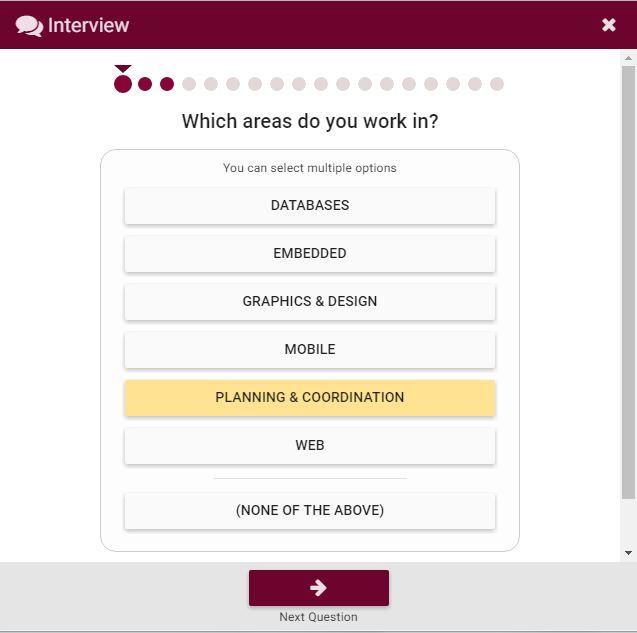
Creating a competency profile doesn’t require an unstructured search for buzzwords. Instead, users simply click through a predefined questionnaire. It is adjustable any time.
How to Plan Projects with iCombine
With each employee present in the system, the account-admin declares project managers. These managers can start planning projects at any time. It is beneficial to lay out an initial plan as soon as there is a project opportunity (like a client with a problem the organization is able to solve), so that the initial requirements can be captured and iteratively improved.

The project initiation only takes a few clicks.
Subsequently to creating the project, the manager defines so called roles. Imagine a role in iCombine like a mini job posting: it includes all the requirements that are needed to achieve the project goal. A role can be staffed by only one or multiple employees in the organization.
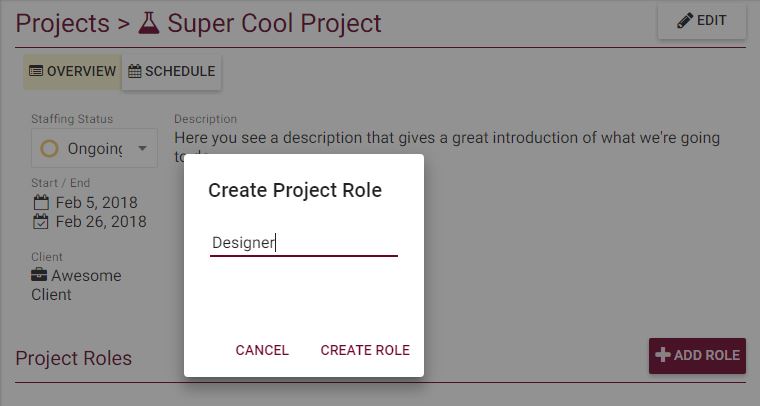
There is no limit to the number of overall roles.
As a next step, the project manager defines the competency requirements of the role. This is done by clicking on the desired skills and interests. Depending on the complexity of the role, this takes a couple of seconds or a few minutes.
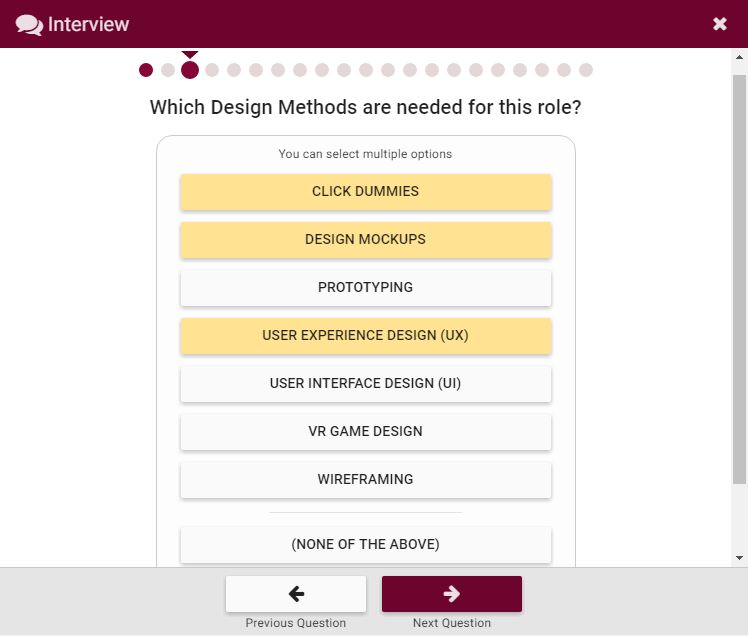
The questionnaire is dynamic. Users will only have to answer relevant questions.
The project manager instantly gets a selection of employees. iCombine automatically calculates the fit between each employee profile and the previously created role profile.
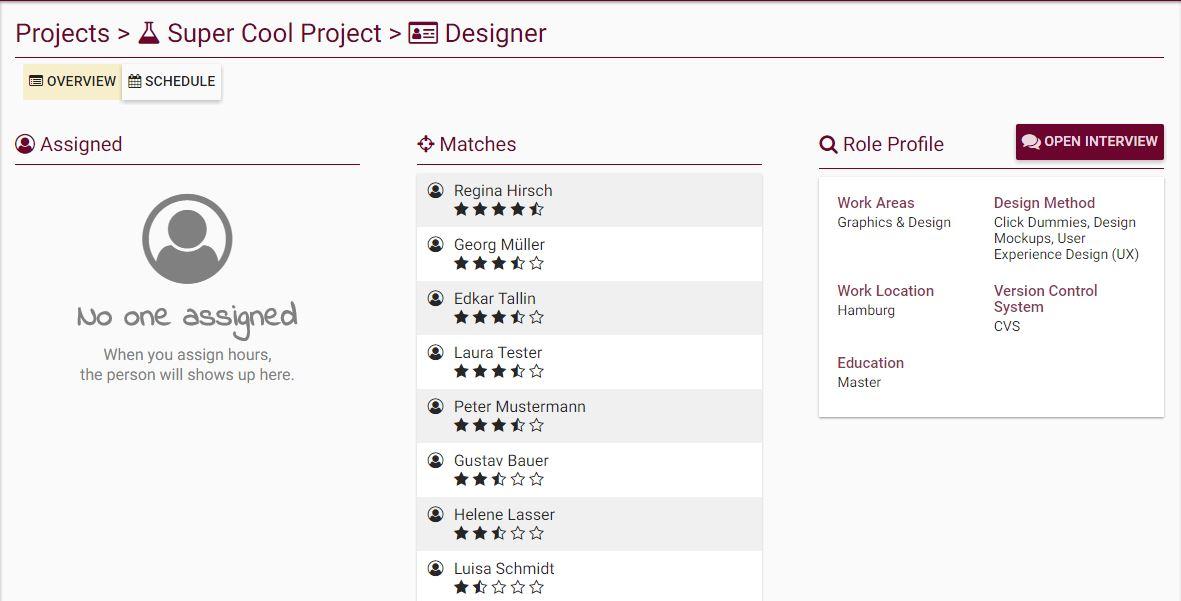
The stars indicate the fit between employee profile and role profile.
After getting a first overview of matching employees, the manager can switch to the schedule view. Here, he can see match details highlighted in the employee profile as well as availability and other assignments per employee.
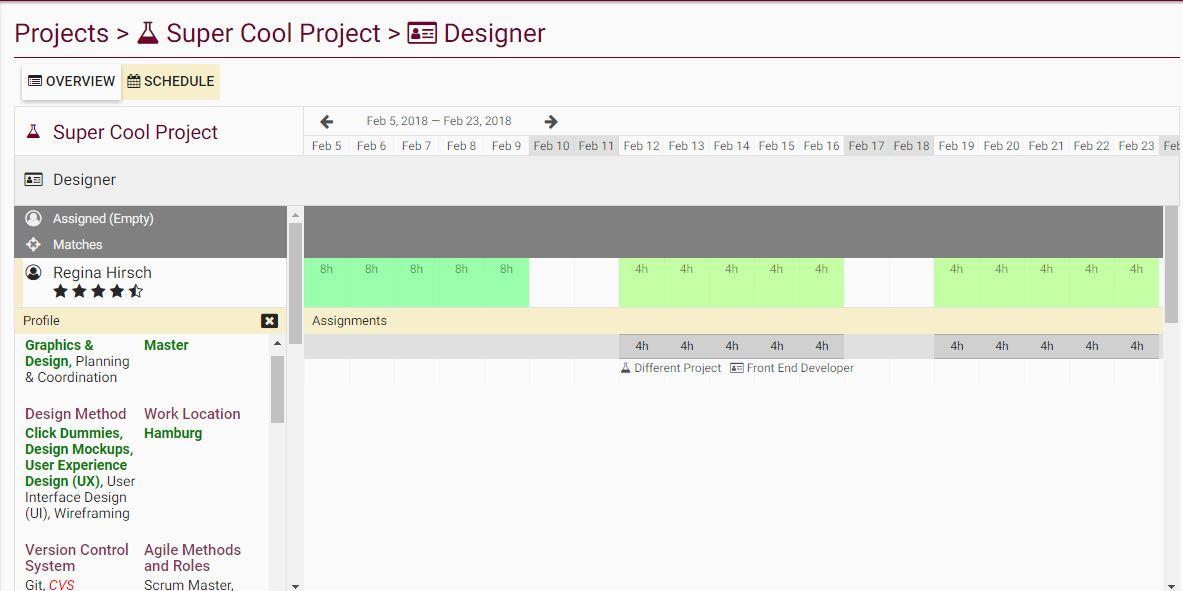
The green and left criteria on the left side indicate the match between employee profile and role profile. On the right side, the users sees availability and existing project assignments.
With all information available, managers can staff the best internal talent in a quick, intelligent and transparent way. Managers not only have access to the relevant skill profiles, but also see availabilities. In the screenshot below you see two red fields. This signals to the manager that utilization is too high. In this case, the project manager should choose an alternative employee or reduce hours to prevent overtime work or conflicts with other projects.
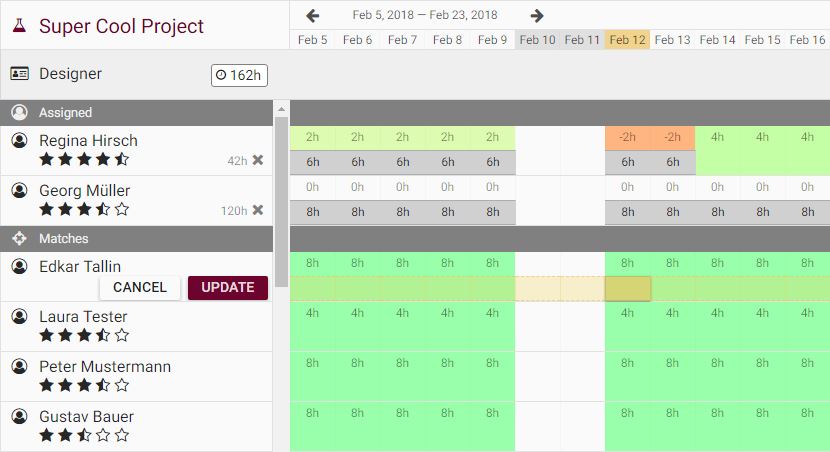
Two employees are assigned to the “Designer” role, a third person is about to be added.
When the manager is done staffing one role, he can switch to the next role of the project. This process is repeated until the project requirements are met, and all needed employees have been identified and staffed. The plan can be reviewed as seen in the screenshot below. Also it can be updated at any time if requirements change or employees need to be shifted around (because of holiday, illness or other reasons).
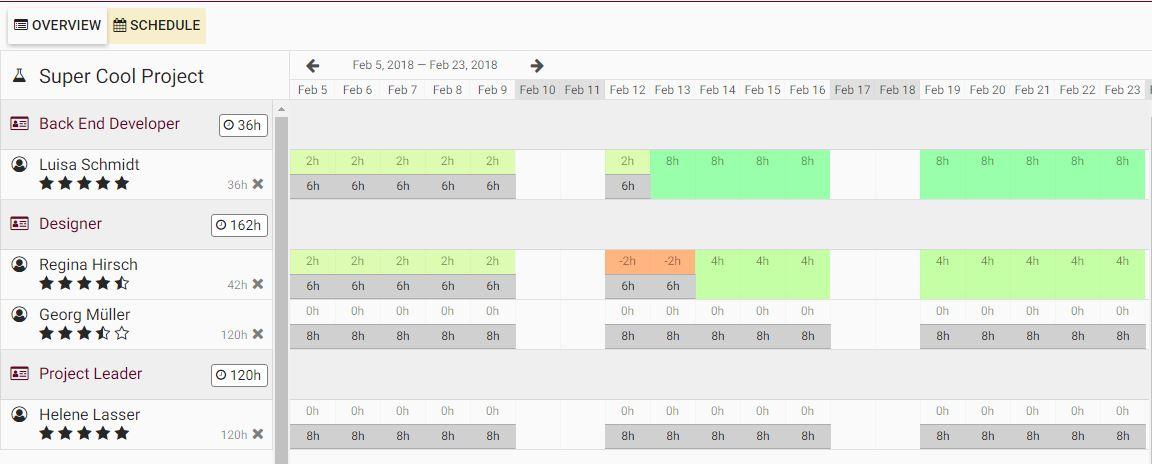
Here, the user can see roles (Back End Developer, Designer and Project Leader), the overall time assigned per role, the assigned employees and their remaining capacity.
As you can see, the time between initiation and start of the project will decrease significantly due to a more streamlined planning process with the help of our software.
Early Access Phase Starts Now
Currently, we are offering an exclusive early access phase to potential customers. Our first users right now are project organizations in the software development sector. Furthermore, we’re in negotiations with consultancies, agencies, co-working spaces and large corporations who want to transform parts of their organization. We’re looking forward to receive recommendations and new contacts. Please get in touch with our Co-Founder and CEO Richard via schentke@icombine.de or schedule a demo directly on our website.
The Future of iCombine – Next Steps
Based on feedback of our pilot customers, we will gradually improve iCombine and add new features. With this procedure, we aim to avoid undesirable developments and misguided assumptions. Our goal is to build a product that really reduces workloads while contributing to the overall success of the company.
Here is an outline of our next steps, see it as a rough road map of iCombine. Notice, that this is not set in stone and will be heavily influenced by the project planning challenges of our customers.
- enable employees to actively apply to project roles. Every employee will see a list of roles that have to be staffed. This list is ranked according to fit in relation to own interests and skills. This bottom-up approach aims at raising collaboration, self-organization and motivation within the company. (UPDATE: Check out our new feature Project Invitations)
- analyze gaps between role profiles and employee profiles in order to suggest training initiatives for individuals, teams or the whole company.
- identify skills that should be hired in order to enrich the competency matrix of the existing workforce.
- allow companies to include freelancers into the project planning process. This way, companies might realize projects although the capacity of certain internal employees is low.
- install a feedback loop after projects ended. It helps to verify employee competencies and enrich future team constellation.
We are excited to move forward. Leave us a comment or email if you are too. We are happy to hear from you!

